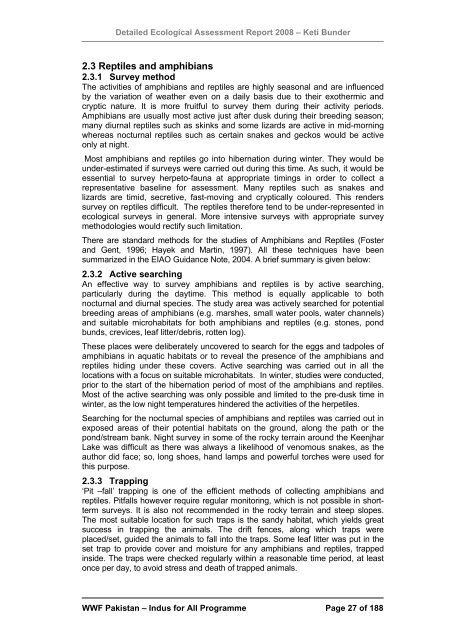Disclaimer note - WWF - Pakistan
Disclaimer note - WWF - Pakistan
Disclaimer note - WWF - Pakistan
Create successful ePaper yourself
Turn your PDF publications into a flip-book with our unique Google optimized e-Paper software.
Detailed Ecological Assessment Report 2008 – Keti Bunder<br />
2.3 Reptiles and amphibians<br />
2.3.1 Survey method<br />
The activities of amphibians and reptiles are highly seasonal and are influenced<br />
by the variation of weather even on a daily basis due to their exothermic and<br />
cryptic nature. It is more fruitful to survey them during their activity periods.<br />
Amphibians are usually most active just after dusk during their breeding season;<br />
many diurnal reptiles such as skinks and some lizards are active in mid-morning<br />
whereas nocturnal reptiles such as certain snakes and geckos would be active<br />
only at night.<br />
Most amphibians and reptiles go into hibernation during winter. They would be<br />
under-estimated if surveys were carried out during this time. As such, it would be<br />
essential to survey herpeto-fauna at appropriate timings in order to collect a<br />
representative baseline for assessment. Many reptiles such as snakes and<br />
lizards are timid, secretive, fast-moving and cryptically coloured. This renders<br />
survey on reptiles difficult. The reptiles therefore tend to be under-represented in<br />
ecological surveys in general. More intensive surveys with appropriate survey<br />
methodologies would rectify such limitation.<br />
There are standard methods for the studies of Amphibians and Reptiles (Foster<br />
and Gent, 1996; Hayek and Martin, 1997). All these techniques have been<br />
summarized in the EIAO Guidance Note, 2004. A brief summary is given below:<br />
2.3.2 Active searching<br />
An effective way to survey amphibians and reptiles is by active searching,<br />
particularly during the daytime. This method is equally applicable to both<br />
nocturnal and diurnal species. The study area was actively searched for potential<br />
breeding areas of amphibians (e.g. marshes, small water pools, water channels)<br />
and suitable microhabitats for both amphibians and reptiles (e.g. stones, pond<br />
bunds, crevices, leaf litter/debris, rotten log).<br />
These places were deliberately uncovered to search for the eggs and tadpoles of<br />
amphibians in aquatic habitats or to reveal the presence of the amphibians and<br />
reptiles hiding under these covers. Active searching was carried out in all the<br />
locations with a focus on suitable microhabitats. In winter, studies were conducted,<br />
prior to the start of the hibernation period of most of the amphibians and reptiles.<br />
Most of the active searching was only possible and limited to the pre-dusk time in<br />
winter, as the low night temperatures hindered the activities of the herpetiles.<br />
Searching for the nocturnal species of amphibians and reptiles was carried out in<br />
exposed areas of their potential habitats on the ground, along the path or the<br />
pond/stream bank. Night survey in some of the rocky terrain around the Keenjhar<br />
Lake was difficult as there was always a likelihood of venomous snakes, as the<br />
author did face; so, long shoes, hand lamps and powerful torches were used for<br />
this purpose.<br />
2.3.3 Trapping<br />
‘Pit –fall’ trapping is one of the efficient methods of collecting amphibians and<br />
reptiles. Pitfalls however require regular monitoring, which is not possible in shortterm<br />
surveys. It is also not recommended in the rocky terrain and steep slopes.<br />
The most suitable location for such traps is the sandy habitat, which yields great<br />
success in trapping the animals. The drift fences, along which traps were<br />
placed/set, guided the animals to fall into the traps. Some leaf litter was put in the<br />
set trap to provide cover and moisture for any amphibians and reptiles, trapped<br />
inside. The traps were checked regularly within a reasonable time period, at least<br />
once per day, to avoid stress and death of trapped animals.<br />
<strong>WWF</strong> <strong>Pakistan</strong> – Indus for All Programme Page 27 of 188

















